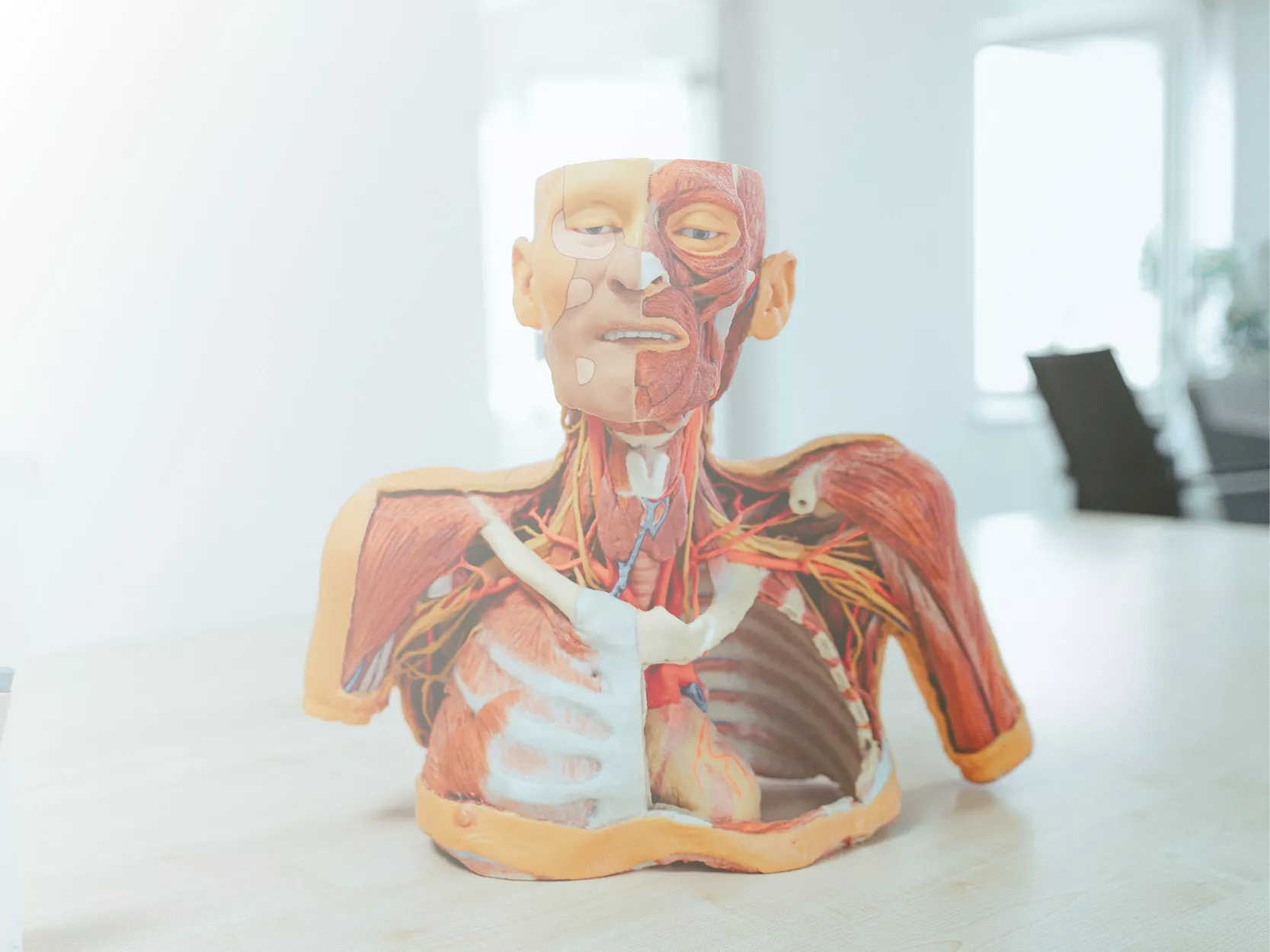Produktinformationen "Glioblastoma multiforme"
Klinische Vorgeschichte
Über einen Zeitraum von 3 Jahren litt eine 57-jährige Frau an intermittierenden Stirnkopfschmerzen und Gedächtnisstörungen, die sich zu psychiatrischen Symptomen, Erbrechen und Meningismus entwickelten. Lokal neurologische Ausfälle traten erst spät auf.
Pathologie
In koronaren Hirnschnitten zeigt sich ein runde, hämorrhagische und unterschiedlich gefärbte Tumor im linken Temporallappen. Das Tumorgewebe erstreckt sich über die Mittellinie und ersetzt den Corpus callosum. Das Ventrikelsystem ist nahezu komplett obliteriert. Weitere Schnitte bestätigten, dass es sich um einen einzigen großen Tumor handelt.
Weitere Informationen
Gliome sind nach Meningeomen die zweithäufigsten Tumoren des ZNS. Sie ähneln histologisch normalen Makrogliazellen wie Astrozyten, Oligodendrozyten und Ependymzellen und entstehen aus entsprechenden Vorläuferzellen. Das Glioblastom multiforme (GBM), ein Grad IV Astrozytom, kann de novo oder aus niedriggradigen Gliomen entstehen. Charakteristisch sind Nekrosen, umgeben von anaplastischen Zellen und hyperplastischen Gefäßen. GBMs treten häufiger bei Männern auf und werden meist im 6. Lebensjahrzehnt diagnostiziert. Risikofaktoren sind Neurofibromatose Typ 1, Li-Fraumeni-Syndrom und frühere Hirnstrahlentherapie. Symptome variieren je nach Lage und umfassen Kopfschmerzen, Sehstörungen, Erbrechen, Appetitverlust, Stimmungsschwankungen, kognitive Veränderungen, neu aufgetretene Anfälle und Sprachstörungen. Diagnostisch werden CT und MRT eingesetzt. Etwa 50 % der GBMs betreffen mehr als eine Hemisphäre, infiltrieren oft Ventrikelwände oder Hirnhäute und erreichen gelegentlich den Liquor. Metastasen außerhalb des ZNS sind selten. Das Tumorwachstum führt zu Hirnödem und erhöhtem Hirndruck. Ohne Behandlung beträgt die mittlere Überlebenszeit etwa 3 Monate. Die Therapie besteht aus Operation, Strahlen- und Chemotherapie.
Über einen Zeitraum von 3 Jahren litt eine 57-jährige Frau an intermittierenden Stirnkopfschmerzen und Gedächtnisstörungen, die sich zu psychiatrischen Symptomen, Erbrechen und Meningismus entwickelten. Lokal neurologische Ausfälle traten erst spät auf.
Pathologie
In koronaren Hirnschnitten zeigt sich ein runde, hämorrhagische und unterschiedlich gefärbte Tumor im linken Temporallappen. Das Tumorgewebe erstreckt sich über die Mittellinie und ersetzt den Corpus callosum. Das Ventrikelsystem ist nahezu komplett obliteriert. Weitere Schnitte bestätigten, dass es sich um einen einzigen großen Tumor handelt.
Weitere Informationen
Gliome sind nach Meningeomen die zweithäufigsten Tumoren des ZNS. Sie ähneln histologisch normalen Makrogliazellen wie Astrozyten, Oligodendrozyten und Ependymzellen und entstehen aus entsprechenden Vorläuferzellen. Das Glioblastom multiforme (GBM), ein Grad IV Astrozytom, kann de novo oder aus niedriggradigen Gliomen entstehen. Charakteristisch sind Nekrosen, umgeben von anaplastischen Zellen und hyperplastischen Gefäßen. GBMs treten häufiger bei Männern auf und werden meist im 6. Lebensjahrzehnt diagnostiziert. Risikofaktoren sind Neurofibromatose Typ 1, Li-Fraumeni-Syndrom und frühere Hirnstrahlentherapie. Symptome variieren je nach Lage und umfassen Kopfschmerzen, Sehstörungen, Erbrechen, Appetitverlust, Stimmungsschwankungen, kognitive Veränderungen, neu aufgetretene Anfälle und Sprachstörungen. Diagnostisch werden CT und MRT eingesetzt. Etwa 50 % der GBMs betreffen mehr als eine Hemisphäre, infiltrieren oft Ventrikelwände oder Hirnhäute und erreichen gelegentlich den Liquor. Metastasen außerhalb des ZNS sind selten. Das Tumorwachstum führt zu Hirnödem und erhöhtem Hirndruck. Ohne Behandlung beträgt die mittlere Überlebenszeit etwa 3 Monate. Die Therapie besteht aus Operation, Strahlen- und Chemotherapie.
Erler-Zimmer
Erler-Zimmer GmbH & Co.KG
Hauptstrasse 27
77886 Lauf
Germany
info@erler-zimmer.de
Achtung! Medizinisches Ausbildungsmaterial, kein Spielzeug. Nicht geeignet für Personen unter 14 Jahren.
Attention! Medical training material, not a toy. Not suitable for persons under 14 years of age.






































